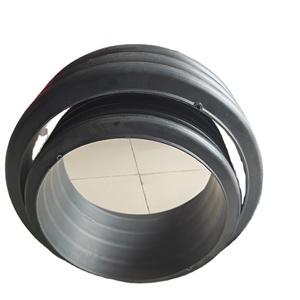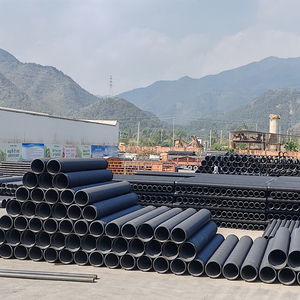(205 products available)























































































































































































































The SN4 HDPE corrugated tube comes in some variants, depending on the needs and requirements of consumers. Such variants include:
Single-wall corrugated pipes
The single-wall corrugated pipes are thus simple and ergonomic structures where a single layer of HDPE forms a pipe with a corrugated and smooth interior and exterior. Even though such tubes are lesser in thickness in comparison to dual-wall tubes, they are favorable for tough waters or environments. These compact tubes are often used for draining purposes including agriculture or as a construction underpinning drain. In the recent past, such pipes have become popular in sewage and wastewater management due to their flexibility and resistance to clogging.
Double-wall corrugated pipes
The synthetic polymer concrete pipes have two distinct layers that come with an inner smooth wall and a outer corrugated wall. This helps combine their toughness, flexibility, and resistance to high pressures or adverse environments. The inner smooth wall facilitates easy carrying or flow, while the outer corrugated wall increases sturdiness and helps in rooting. Such pipes have good erosion resistance properties and support high traffic loads. Double-wall pipes are also called lightweight pipes that are suitable for an array of application purposes which include storm drainage, sanitary sewers, and underground works.
Single-skin pipes
Single-skin pipes are thin pipes made of polyethylene plastic. They are linear polymers that come with high density known as HDPE. These pipes are usually categorized as non-corrugated and corrugated pipes. Non-corrugated single-skin pipes have a plain internal and external surface. Single-wall pipes have an internal and external corrugated surface. Despite the difference in structure, the common factor is that single-skin pipes are made of a single skin of HDPE.
Biological acid-proof pipes
Biological acid-proof pipes are a specific category of hdpe irrigation pipes designed for applications with a high concentration of corrosive substances. Such tissues are resistant to high acidic or alkaline concentrations and come in handy in wastewater treatment facilities before disposal or underground chemical transport for manufacturing organizations.
Perforated corrugated pipes
Perforated SN4 HDPE pipes are embedded with perforations or small holes on their surface to allow permeability. These pipes help facilitate the movement of liquids into or out of the pipe and are often applicable in drainage systems to allow water and other fluids to flow in and out. These pipes are most preferable in groundwater control and agricultural field drainage.
Thanks to its stellar and outrageous properties, the SN4 HDPE corrugated drain pipe has an enormous potential in many industries. These industries include:
Agricultural drainage
In agriculture, SN4 HDPE pipes offer cost-effective solutions for field drainage and irrigation systems. When used for drainage, they help control water levels within the soil. This allows for good crop growth and prevents water logging. For irrigation, they offer systems for water distribution to crops to enhance agricultural production.
Stormwater management
The SN4 HDPE pipes are well used in stormwater management systems because they facilitate rhythms of stormwater drainage, reducing soil erosion and water logging. Their flexible design and resistance to blockage enable effective transport of surface runoff in urban areas and agricultural lands alike.
Sewer system
SN4 HDPE pipes also come in handy for underground sewage or wastewater transfer. Their resistance to chemical corrosion makes them ideal for transferring both household sewage and industrial wastewater without risk of degradation.
Construction underpinning
In construction, these pipes are used as a footing drain to prevent water accumulation or excess pressure against building foundations. This drainage helps prolong the lifespan of structures by reducing the risk of water-related damage to foundations and other parts of the building.
Utility conduit
SN4 HDPE pipes are also applicable as conduits for the installation of utility lines including electricity, gas, and telecommunications. Their strength, flexibility, and resistance to environmental elements ensure long-lasting performance when used either underground or embedded in concrete structures.
Mining operations
In the mining industry, SN4 HDPE pipes have multiple uses including the transport of water for mineral extraction purposes, slurry transportation, and even management of water pollution or mine drainage. Their resistance to chemical corrosion allows them to transport acidic or chemically hazardous liquids safely.
Marine outfalls
SN4 HDPE pipes are used in marine outfalls which are structures designed to discharge treated wastewater from wastewater treatment plants into the sea or ocean.
Some prominent features of this pipe include:
Specifications
SN4 HDPE pipe has diameter sizes that range from 50 mm to 1200 mm. The pipes also have different length sizes ranging from 5m to 50 meters. Such pipes have high stiffness that is measured by Sn , which is around 4 N/mm². The material temperatures can range from -40°C to 60°C measurements with a safety factor of 1.5. The flow coefficient value K for perforated pipes is 0.025 m. The elasticity modulus value E is approximately 1000 N/mm². The pipe weight is proportional to its diameter, for instance, a diameter of 600 mm weighs around 7.7 kg/m.
Durability and corrosion resistance
HDPE has extraordinary durability and comes with stellar immediate benefits such as resistance to chemical and biological attacks, making it suitable for tissues that are entrenched in adverse soil conditions or polluted waters. Unlike metallic pipes, it does not rust or corrode, ensuring a long life and reduced maintenance costs.
Flexibility and lightweight
The flexibility of SN4 HDPE pipes allows them to accommodate ground movement and conform to changing terrains easily. This makes them easy to install in trenches of various shapes and sizes. Moreover, the pipes are manufactured lightweight, which reduces the physical burden on workers and takes ease in transportation and installation, especially in remote areas or difficult access locations.
Hydraulic efficiency
The inner smooth surface of SN4 HDPE pipes exhibits low friction, so water can flow freely with minimal resistance. This enhances their hydraulic efficiency, allowing for better flow rates and reduced chances of blockage. Whether used for drainage, sewage disposal, or stormwater collection, such pipes help ensure effective transport of liquids without pooling or back-up.
Cost-effectiveness
When compared to other traditional piping materials, SN4 HDPE pipes are manufactured with cost-effective crop yields. The resistance to corrosion, durability, flexibility, and low hydraulic friction make this pipe a potentially long-lasting and maintenance-free alternative to sewers, drains, and culverts. The pipes are also manufactured lightweight, thus easy in transport and installation.
Standard compliance
SN4 HDPE pipes are manufactured to comply with European pipe standards. They come with outstanding performance guarantees, especially for civil engineering and construction applications. Such standards compliance ensures this pipe meets minimum safety and performance requirements, making it approved for use in major infrastructure projects.
Buyers should consider the following factors when purchasing HDPE plastic pipe:
Tube quality
Buyers should get tubes made with quality HDPE material. To ensure the material is quality and they get the required standard, they should ensure the manufacturer provides the required quality certifications. They should also ensure the tubes are visible and suited for outdoor use.
Impact resistance
HCPE tubes are normally exposed to extreme weather. Therefore, when getting SN4 HDPE pipes, buyers should ensure they are impact resistant. This is an important aspect that will ensure the pipes last longer as they will withstand adverse weather conditions.
Pipe diameter and length
There are different diameters of corrugated HDPE pipes, such as 50 mm and 1200 mm. Buyers should also consider the length of the pipe and ensure it meets the selling requirements. Manufacturers stock these pipes in various lengths, but most of them are between 5 to 50 meters. If the pipes are spaced out, buyers should get spacers of the same material.
Corrugated type
Buyers should choose either annular or helical pipes. Both types have pros and cons, so the final decision will depend on their customers' needs. Buyers looking for pipes that can easily be installed in trenches should find helical pipes, while those for strong cements should get annular pipes.
Jointing system
Buyers should consider the jointing system of the tube. They should choose pipes with effective jointing systems that will prevent leakage. For easier jointing, they should get pipes with electrofusion or socket jointing systems.
Application and load bearing capacity
When purchasing these pipes, buyers should consider the use their customers intend for the pipe and the weight it is meant to carry. Buyers should ensure the pipes they purchase are strong and can withstand all the cements they come in contact with. Also, check if they are suitable for erosion and chemical resistance.
Standards compliance
For buyers purchasing these pipes for construction purposes, they should ensure the pipes meet the required international and national standards. The pipes should have proof of certification.
SN4 means that the pipe is rated at a minimum value of 4 KN. This is the required load the pipe can hold per square meter.
Corrugated pipes, especially HDPE made, are widely used for underground drainage. They are preferred because of their strength, flexibility, and resistance to erosion and chemical ingredients. They are used for storm sewers, French drains, culvert extensions, and other applications requiring water diversion.
HDPE corrugated pipes are estimated to last 50 to 100 years. Their life is influenced by several factors, such as placement conditions, exposure to chemicals, and the kind of load placed on them.
SN4 HDPE pipes are used for underground drainage and other cement-filled culverts. They are also used for storm drains, French drains, and other applications diverting water.
To protect HDPE pipes from damage or extreme weather, manufacturers recommend burying them at least 12 inches deep. The standard for burying them is 12 inches, although the depth can vary depending on the pipe size.